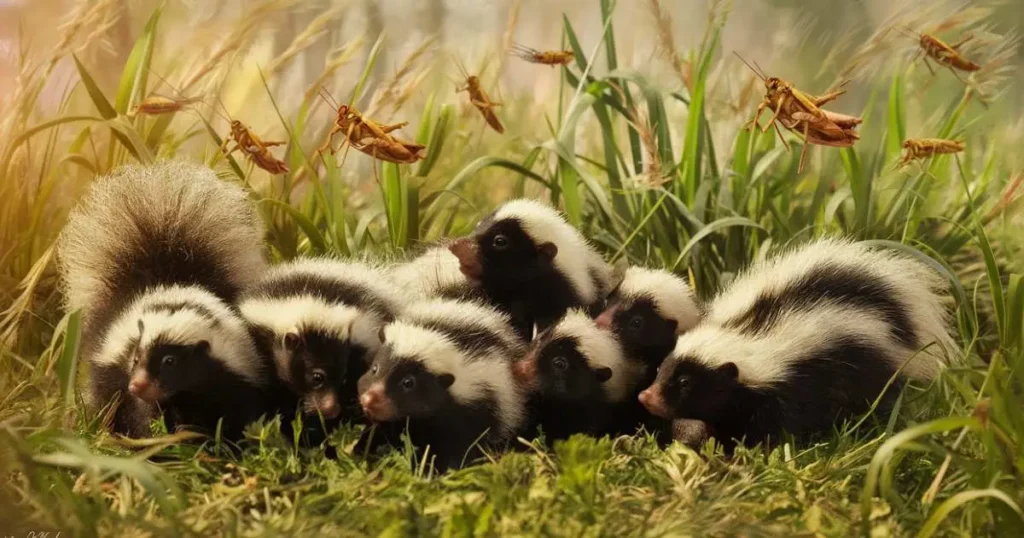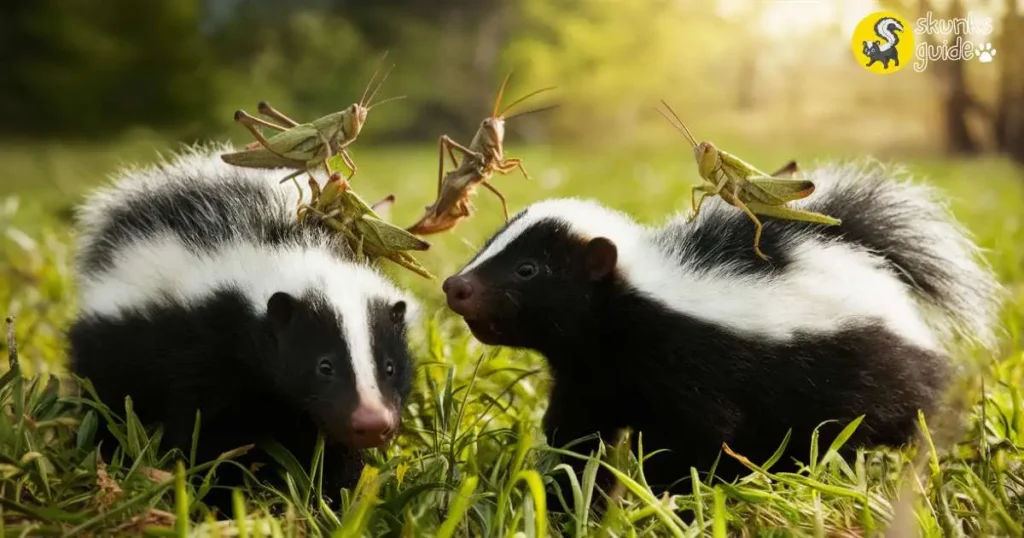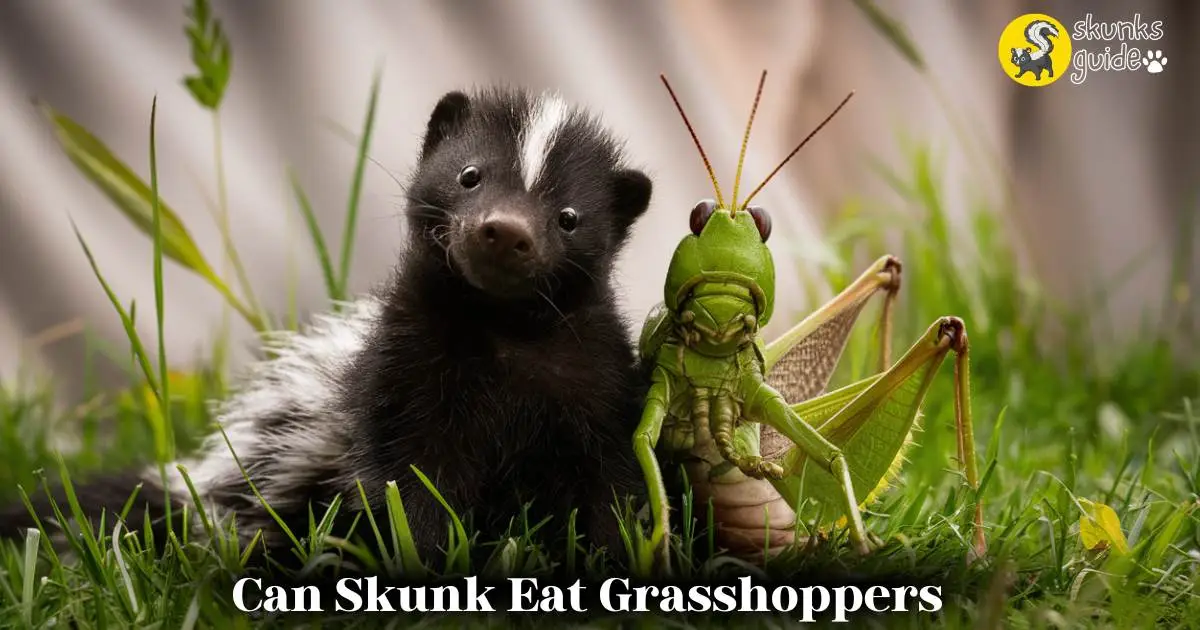Can Skunk Eat Grasshoppers? Vet-Approved Nutrition Facts
Yes, skunks eat grasshoppers. Skunks are omnivores and their diet includes insects like grasshoppers.
Skunks are fascinating creatures known for their distinctive black and white coloring. They play a vital role in controlling insect populations. These animals are omnivores, meaning they consume both plant and animal matter. Grasshoppers are a common part of their diet, providing essential nutrients.
Skunks are nocturnal, foraging at night for food. Their diet also includes fruits, small mammals, and bird eggs. Understanding skunk diets helps us appreciate their role in the ecosystem. They help keep pest populations in check, benefiting agriculture. Skunks are more than just their infamous spray; they are key players in maintaining ecological balance.
Skunks And Grasshoppers
Skunks are fascinating creatures with a varied diet. One of their favorite snacks includes grasshoppers. Skunks and grasshoppers have an interesting relationship in the wild. Skunks help control the grasshopper population while getting a tasty meal. Let’s dive deeper into their feeding habits and seasonal preferences.

Feeding Habits
Skunks are omnivorous, meaning they eat both plants and animals. Their diet changes based on availability, making them opportunistic feeders. Grasshoppers make a nutritious snack for skunks. They provide protein and are easy to catch.
Skunks use their keen sense of smell to find grasshoppers. They often hunt during the night when grasshoppers are less active. Skunks dig into the ground or foliage to locate and catch their prey. Here are some key points about skunks’ feeding habits:
- Omnivorous diet: Skunks eat fruits, insects, small mammals, and even garbage.
- Night hunters: They prefer to hunt at night, using their sense of smell to locate food.
- Opportunistic feeders: They eat what is available, making them adaptable to different environments.
Skunks consume a variety of insects, including grasshoppers. In addition to insects, they eat small rodents, birds, eggs, and berries. This diverse diet helps them thrive in various habitats.
Seasonal Preferences
Skunks’ diet varies with the seasons. In spring and summer, they eat more insects like grasshoppers. These insects are abundant during warmer months. Skunks take advantage of this bounty to get the nutrients they need.
During the fall, skunks shift their diet to fruits and nuts. These foods help them store fat for the winter. In winter, food is scarcer. Skunks rely on their fat reserves and scavenge for any available food.
Here’s a seasonal breakdown of skunks’ diet:
| Season | Primary Food Sources |
|---|---|
| Spring | Insects (grasshoppers), small mammals, eggs |
| Summer | Insects (grasshoppers), berries, fruits |
| Fall | Fruits, nuts, small mammals |
| Winter | Scavenged food, stored fat reserves |
Skunks adapt their feeding habits to the changing seasons. This ensures they get the necessary nutrients year-round. By eating grasshoppers in spring and summer, they maintain a balanced diet. This dietary flexibility helps skunks survive in diverse environments.
Foraging Techniques
Skunks are fascinating creatures, known for their distinctive black and white stripes. But did you know they have unique foraging techniques? Skunks eat various insects, including grasshoppers. Understanding their foraging methods can help us learn more about these intriguing animals and their role in the ecosystem.

Hunting Methods
Skunks use diverse hunting methods to catch their prey. They mainly hunt at night, taking advantage of their excellent sense of smell and hearing. Skunks can locate grasshoppers even in the dark.
Here are some key hunting techniques skunks use:
- Sniffing the Ground: Skunks often sniff the ground to find hidden grasshoppers.
- Digging: Skunks dig into the soil or under leaves where grasshoppers hide.
- Stalking Slowly: They move slowly and silently to avoid scaring their prey.
- Pouncing: Once they locate a grasshopper, they pounce quickly to capture it.
Skunks have strong claws, which help them dig and catch grasshoppers. Their agility allows them to move swiftly and effectively during the hunt.
Eating Patterns
Once a skunk catches a grasshopper, its eating patterns are quite interesting. Skunks prefer eating their prey immediately. They chew thoroughly to extract all the nutrients.
Key eating habits include:
- Immediate Consumption: Skunks eat the grasshoppers right after catching them.
- Chewing Thoroughly: They chew well to break down the tough exoskeleton.
- High Protein Diet: Grasshoppers provide essential proteins and nutrients for skunks.
Skunks do not store their food. They rely on fresh catches for their diet. This behavior ensures they get the most nutrition from their prey.
Understanding the foraging techniques of skunks provides insight into their survival strategies and their impact on the insect population.
Impact On Ecosystem
Skunks are fascinating creatures with diverse diets. One of their favorite snacks is grasshoppers. This dietary preference has a significant impact on the ecosystem. By consuming grasshoppers, skunks play a crucial role in maintaining balance in the environment. Let’s explore this impact further under two key aspects: Food Chain Dynamics and Pest Control.
Food Chain Dynamics
Skunks are omnivores, meaning they eat both plants and animals. Grasshoppers are a part of their diet, affecting the food chain dynamics. Here’s how:
- Primary Consumers: Grasshoppers feed on plants, making them primary consumers. They convert plant energy into a form that other animals, like skunks, can consume.
- Secondary Consumers: Skunks, as secondary consumers, eat grasshoppers. This helps control the grasshopper population, preventing overgrazing of plants.
By eating grasshoppers, skunks help maintain the balance between plants and primary consumers. This balance is crucial for a healthy ecosystem. Without it, plant life could suffer, leading to a cascade of negative effects on other species.
Here’s a simple table to illustrate this dynamic:
| Level | Organism | Role |
|---|---|---|
| Primary Producers | Plants | Convert sunlight into energy |
| Primary Consumers | Grasshoppers | Feed on plants |
| Secondary Consumers | Skunks | Feed on grasshoppers |
Skunks, by eating grasshoppers, ensure that the energy flow in the ecosystem remains uninterrupted. This balance supports biodiversity and ecosystem health.
Pest Control
Grasshoppers can become pests when their populations grow too large. They can damage crops and plants, causing economic and ecological problems. Skunks help control grasshopper populations naturally. This makes them valuable allies in pest control.
Here are some benefits of skunks as pest controllers:
- Reduce Crop Damage: By eating grasshoppers, skunks reduce the number of pests that can damage crops.
- Protect Plant Life: Fewer grasshoppers mean less damage to wild plants and flowers, supporting a healthy ecosystem.
- Natural Solution: Skunks provide a natural pest control solution, reducing the need for chemical pesticides.
Farmers and gardeners benefit from skunks’ appetite for grasshoppers. They enjoy healthier crops and gardens with fewer pests. This symbiotic relationship highlights the importance of skunks in maintaining ecological balance.
In summary, skunks play a vital role in pest control by eating grasshoppers. They help protect crops and plants, contributing to a healthier environment.
Skunk Species Variations
Skunks are fascinating creatures with a diverse diet. One question often asked is: Do skunks eat grasshoppers? The answer varies depending on the skunk species. Skunks are found in different regions, and their diet can change based on availability and habitat. This blog post explores the variations in skunk species and how these differences affect their eating habits, particularly their consumption of grasshoppers.
Common Species
There are several common species of skunks, each with unique characteristics. The most well-known skunk species include:
- Striped Skunk – Found across North America, recognized by its black fur with white stripes.
- Spotted Skunk – Smaller and more agile, with distinct spots instead of stripes.
- Hog-Nosed Skunk – Known for its pig-like snout, found in the southwestern United States and Central America.
- Hooded Skunk – Identified by its long fur and bushy tail, inhabits regions in the southwestern United States and Mexico.
Each species has adapted to its specific environment, which influences its diet. The striped skunk is the most adaptable, living in forests, grasslands, and even urban areas. The spotted skunk prefers rocky terrains and wooded areas, while the hog-nosed skunk thrives in arid regions. The hooded skunk is more common in desert habitats.
Dietary Differences
Skunks are omnivores, meaning they eat both plants and animals. Their diet can include insects, small mammals, fruits, and plants. Grasshoppers are a common food source for many skunk species, but the frequency and amount vary.
Striped Skunks have a diverse diet that changes with the seasons. In spring and summer, they eat more insects, including grasshoppers. In fall and winter, they consume more fruits and small mammals.
Spotted Skunks are more insectivorous. They eat many insects, such as grasshoppers, beetles, and crickets. Their small size and agility help them catch these fast-moving prey.
Hog-nosed skunks have a unique diet due to their habitat. They dig for insects and roots with their snouts. Grasshoppers are part of their diet, but they also eat a variety of other insects.
Hooded Skunks also eat a mix of insects, fruits, and small animals. Grasshoppers are a part of their diet, especially in the warm months when these insects are more abundant.
Below is a table summarizing the dietary preferences of common skunk species:
| Skunk Species | Dietary Preference |
|---|---|
| Striped Skunk | Insects, small mammals, fruits, plants |
| Spotted Skunk | Insects (grasshoppers, beetles), small mammals |
| Hog-Nosed Skunk | Insects, roots, small mammals |
| Hooded Skunk | Insects, fruits, small animals |
Understanding these dietary differences helps us see how skunk species adapt to their environments. Each species has developed unique habits and preferences, making them fascinating subjects for study.
Human Interaction
Skunks are known for their distinctive smell and nocturnal habits. But did you know they have a varied diet that includes grasshoppers? Understanding how skunks interact with humans can shed light on their eating habits and behaviors. From being seen as pests to knowing how to attract them, skunks play a unique role in our ecosystem.
Skunks As Pests
Skunks often get a bad reputation because they are seen as pests. Their nocturnal activity can lead to unexpected encounters with humans. Skunks dig up lawns looking for insects like grasshoppers and grubs.
Common issues caused by skunks include:
- Digging up gardens: Skunks search for food and can cause significant damage to your garden beds.
- Raiding garbage cans: They are scavengers and often tip over trash bins to find food scraps.
- Spraying pets or humans: Their defense mechanism can leave a lingering odor that’s hard to remove.
Despite being seen as pests, skunks play a crucial role in controlling insect populations. They eat various pests like grasshoppers, helping maintain a balanced ecosystem.
Here’s a quick table summarizing skunk-related problems and benefits:
| Problem | Benefit |
|---|---|
| Damages lawns and gardens | Controls insect populations |
| Raids trash bins | Removes harmful insects |
| Sprays foul odor | Aids in pest control |
Attracting Skunks
Attracting skunks to your yard might sound odd, but it can have its benefits. Skunks help control insect populations by eating pests like grasshoppers. If you want to attract skunks, there are a few things you can do.
Tips to attract skunks:
- Provide food sources: Skunks are attracted to grubs, insects, and even pet food.
- Create shelters: Skunks seek out safe places to hide. Rock piles or woodpiles make excellent shelters.
- Water sources: A small water dish can attract skunks to your yard, especially in dry climates.
Be mindful when attracting skunks, as their spray can be a nuisance. Always keep a safe distance and respect their space.
Here’s a simple list of what skunks like:
- Insects and grubs
- Pet food
- Safe shelters
- Water sources
Understanding skunks’ behavior can help you coexist with these fascinating creatures. By attracting them, you can benefit from their natural pest control abilities.
Frequently Asked Questions
Can Skunks Eat Insects?
Yes, skunks eat insects. In fact, insects make up a significant portion of their diet. Skunks are known to consume beetles, grasshoppers, crickets, and many other types of insects, along with small mammals and birds.
What Do Skunks Like To Eat At Night?
Skunks at night prefer to eat insects, small rodents, reptiles, and fruit. They are omnivorous creatures and have a diverse diet. Additionally, they are opportunistic animals that will eat whatever they can find. Skunks are mostly active during nighttime and can search for food anywhere from forests to suburban areas.
What Attracts Skunks To Your Yard?
Skunks are attracted to yards that offer food, shelter, and water sources. They feed on insects, grubs, fruits, and vegetables. Yards with unsecured trash cans or pet food left outside can also attract skunks. Dense vegetation, woodpiles, and structures like sheds or decks provide shelter.
Any accessible standing water source can also attract skunks to your yard.
What Is The Only Animal That Will Eat A Skunk?
The great horned owl is the only animal that will eat a skunk.
Conclusion
Skunks do eat grasshoppers, along with other insects. This diet helps keep the ecosystem balanced. Understanding skunk diets can help improve wildlife management. Next time you see a skunk, remember they play a crucial role in nature. Their diverse diet makes them important for insect control.

